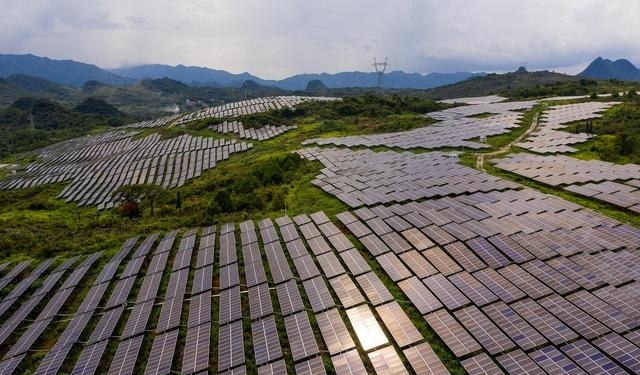From January to November 2021, the newly installed photovoltaic capacity in China was 34.8GW, a year-on-year increase of 34.5%. Considering that nearly half of the installed capacity in 2020 will take place in December, the growth rate for the whole year of 2021 will be much lower than market expectations. China Photovoltaic Industry Association lowered its annual installed capacity forecast by 10GW to 45-55GW.
After the carbon peak in 2030 and the goal of carbon neutrality in 2060 are put forward, all walks of life generally believe that the photovoltaic industry will usher in a historic golden development cycle, but the price hike throughout 2021 has created an extreme industrial environment.
From top to bottom, the photovoltaic industry chain is roughly divided into four manufacturing links: silicon materials, silicon wafers, cells and modules, plus power station development, a total of five links.
After the start of 2021, the price of silicon wafers, cell conduction, superimposed glass, EVA film, backplane, frame and other auxiliary materials will increase. The module price was pushed back to 2 yuan/W three years ago during the year, and it will be 1.57 in 2020. Yuan/W. In the past decade or so, component prices have basically followed the unilateral downward logic, and the price reversal in 2021 has restrained the willingness to install downstream power stations.
In the future, the uneven development of various links in the photovoltaic industry chain will continue. Ensuring the security of the supply chain is an important issue for all companies. Price fluctuations will greatly reduce the compliance rate and damage the reputation of the industry.
Based on the downward expectations of the price of the industry chain and the huge domestic project reserves, the Photovoltaic Industry Association predicts that the newly installed photovoltaic capacity in 2022 is likely to exceed 75GW. Among them, the distributed photovoltaic climate is gradually taking shape, and the market is beginning to take shape.
Stimulated by the dual-carbon goals, capital is scrambling to increase photovoltaics, a new round of capacity expansion has begun, structural excess and imbalances still exist, and may even intensify. Under the fight between new and old players, the industry structure is inevitable.
1、There is still a good year for silicon materials
Under the price hike in 2021, the four major links of photovoltaic manufacturing will be uneven.
From January to September, the prices of silicon materials, silicon wafers, solar cells, and modules increased by 165%, 62.6%, 20%, and 10.8%, respectively. The price increase is due to the high supply of silicon materials and high price shortages. The highly concentrated silicon wafer companies also reaped dividends in the first half of the year. In the second half of the year, profits shrank due to the release of new production capacity and the exhaustion of low-cost inventories; the ability to pass costs on the battery and module ends Significantly weaker, and profits are severely damaged.
With the opening of a new round of capacity competition, the profit distribution on the manufacturing side will change in 2022: Silicon materials continue to make profits, silicon wafer competition is fierce, and battery and module profits are expected to be restored.
Next year, the overall supply and demand of silicon materials will remain tightly balanced, and the price center will move downward, but this link will still maintain higher profits. In 2021, the total supply of about 580,000 tons of silicon materials basically matches the demand for terminal installations; however, compared with the silicon wafer end with a production capacity of more than 300 GW, it is in short supply, leading to the phenomenon of rushing, hoarding, and driving up prices in the market.
Although the high profits of silicon materials in 2021 have led to production expansion, due to high entry barriers and long production expansion cycles, the gap in production capacity with silicon wafers next year will still be obvious.
At the end of 2022, the domestic polysilicon production capacity will be 850,000 tons/year. Taking into account the overseas production capacity, it can meet the installed demand of 230GW. At the end of 2022, only Top5 silicon wafer companies will add about 100GW of new capacity, and the total capacity of silicon wafers will be close to 500GW.
Taking into account uncertain factors such as the pace of capacity release, dual energy consumption control indicators, and overhauls, new silicon production capacity will be limited in the first half of 2022, superimposed on rigid downstream demand, and tightly balanced supply and demand. Supply tensions in the second half of the year will be effectively alleviated.
In terms of silicon material prices, the first half of 2022 will decline steadily, and the decline may accelerate in the second half of the year. The annual price may be 150,000-200,000 yuan/ton.
Although this price has fallen from 2021, it is still at an absolute high in history, and the capacity utilization rate and profitability of leading manufacturers will continue to remain high.
Stimulated by prices, almost all leading domestic silicon materials have already thrown out plans to expand their production. Generally speaking, the production cycle of a silicon material project is about 18 months, the release rate of production capacity is slow, the flexibility of production capacity is also small, and the start-up and shutdown costs are high. Once the terminal starts to adjust, the silicon material link will fall into a passive state.
The short-term supply of silicon materials continues to be tight, and production capacity will continue to be released in the next 2-3 years, and supply may exceed demand in the medium and long term.
At present, the planned production capacity announced by silicon companies has exceeded 3 million tons, which can meet the installed demand of 1,200GW. Considering the huge capacity under construction, the good days for silicon companies are likely to be only 2022.
2、The era of high-profit silicon wafers is over
In 2022, the silicon wafer segment will taste the bitter fruit of over-expanding production capacity and become the most competitive segment. Profits and industrial concentration will decline, and it will bid farewell to the five-year high-profit era.
Stimulated by the dual-carbon goals, the high-profit, low-threshold silicon wafer segment is more favored by capital. The excess profits gradually disappear with the expansion of production capacity, and the price increase of silicon materials accelerates the erosion of silicon wafer profits. In the second half of 2022, with the release of new silicon material production capacity, a price war is likely to occur on the silicon wafer end. By then, profits will be greatly squeezed, and some of the second and third-line production capacity may withdraw from the market.
With the callback of upstream silicon material and wafer prices, and the support of strong downstream demand for installed capacity, the profitability of solar cells and components in 2022 will be repaired, and there will be no need to suffer from splintering.
3、Photovoltaic manufacturing will form a new competitive landscape
According to the above inference, the most painful part of the photovoltaic industry chain in 2022 is the severe surplus of silicon wafers, among which specialized silicon wafer manufacturers are the most; the happiest ones are still silicon material companies, and the leaders will make the most profits.
At present, the financing capacity of photovoltaic companies has been greatly enhanced, but the rapid technological progress has led to accelerated asset depreciation. In this context, vertical integration is a double-edged sword, especially in the two links where batteries and silicon materials are over-invested. Collaboration is a good way.
With the restructuring of industry profits and the influx of new players, the competitive landscape of the photovoltaic industry in 2022 will also have large variables.
Stimulated by the dual-carbon goals, more and more new entrants are investing in photovoltaic manufacturing, which brings huge challenges to traditional photovoltaic companies and may lead to fundamental changes in the industrial structure.
This is the first time in history that cross-border capital has entered photovoltaic manufacturing on such a large scale. New entrants always have a late starter advantage, and old players without core competitiveness are likely to be easily eliminated by newcomers with rich wealth.
4、Distributed power station is no longer a supporting role
The power station is the downstream link of photovoltaics. In 2022, the power station’s installed capacity structure will also show new features.
Photovoltaic power plants can be roughly divided into two types: centralized and distributed. The latter is subdivided into industrial and commercial and household use. Benefiting from the stimulus of the policy and the policy of subsidizing 3 cents per kilowatt-hour of electricity, user installed capacity has skyrocketed; while centralized installed capacity has shrunk due to price increases, the probability of distributed installed capacity in 2021 will hit a record high, and the proportion of total installed capacity will also be increased. Super centralized for the first time in history.
From January to October 2021, distributed installed capacity was 19GW, accounting for about 65% of the total installed capacity in the same period, of which household use increased by 106% year-on-year to 13.6GW, which was the main source of new installed capacity.
For a long time, the distributed photovoltaic market has been mainly developed by private enterprises because of its fragmentation and small size. The potential installed capacity of distributed photovoltaic in the country exceeds 500GW. However, due to the inadequate understanding of policies by some local governments and enterprises and the lack of overall planning, chaos frequently occurred in actual operations. According to statistics from the China Photovoltaic Industry Association, the scale of large-scale base projects totaling more than 60GW has been announced in China, and the total deployment scale of photovoltaic power plants in 19 provinces (regions and cities) is about 89.28 GW.
Based on this, superimposing the downward expectations of the price of the industry chain, the China Photovoltaic Industry Association predicts that the newly installed photovoltaic capacity in 2022 will be more than 75GW.
<With long-term experience, Xiamen Bright New Energy Co.,Ltd manufactures many kinds and levels of solar lights in Xiamen. More information, please contact Miss Lin(+86 13123388978).>
Post time: Jan-06-2022

